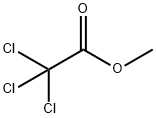| Identification | More | [Name]
Methyl trichloroacetate | [CAS]
598-99-2 | [Synonyms]
METHYL TRICHLOROACETATE
RARECHEM AL BF 1451
TCA-METHYL ESTER
TRICHLOROACETIC ACID METHYL ESTER
trichloro-aceticacimethylester
Methyl trichlroracetate
METHYL TRICHLOROACETATE PESTANAL
Methyltrichloroacetate,99%
Acetic acid, trichloro-, methyl ester
methyl trichloroacetic acid
Methyl trichloroacetate solution | [EINECS(EC#)]
209-960-7 | [Molecular Formula]
C3H3Cl3O2 | [MDL Number]
MFCD00000794 | [Molecular Weight]
177.41 | [MOL File]
598-99-2.mol |
| Safety Data | Back Directory | [Hazard Codes ]
Xi,F | [Risk Statements ]
R36/37/38:Irritating to eyes, respiratory system and skin .
R40:Limited evidence of a carcinogenic effect. | [Safety Statements ]
S26:In case of contact with eyes, rinse immediately with plenty of water and seek medical advice .
S36:Wear suitable protective clothing .
S16:Keep away from sources of ignition-No smoking . | [RIDADR ]
UN 2533 6.1/PG 3
| [WGK Germany ]
3
| [RTECS ]
AJ8380000 | [TSCA ]
Yes | [HazardClass ]
6.1(b) | [PackingGroup ]
III | [HS Code ]
29154000 |
| Hazard Information | Back Directory | [General Description]
A colorless liquid. Insoluble in water and denser than water. Contact may slightly irritate skin, eyes and mucous membranes. May be toxic by ingestion. Used to make other chemicals. | [Reactivity Profile]
A halogenated ester. Esters react with acids to liberate heat along with alcohols and acids. Strong oxidizing acids may cause a vigorous reaction that is sufficiently exothermic to ignite the reaction products. Heat is also generated by the interaction of esters with caustic solutions. Flammable hydrogen is generated by mixing esters with alkali metals and hydrides. A mixture of the ester and trimethylamine reacted violently. Polymerization of a reactive dehydrochlorination of the ester was viewed as the most likely product, along with generous amounts of heat. | [Air & Water Reactions]
Insoluble in water. | [Health Hazard]
TOXIC; inhalation, ingestion or contact (skin, eyes) with vapors, dusts or substance may cause severe injury, burns or death. Contact with molten substance may cause severe burns to skin and eyes. Reaction with water or moist air will release toxic, corrosive or flammable gases. Reaction with water may generate much heat that will increase the concentration of fumes in the air. Fire will produce irritating, corrosive and/or toxic gases. Runoff from fire control or dilution water may be corrosive and/or toxic and cause pollution. | [Fire Hazard]
Combustible material: may burn but does not ignite readily. Substance will react with water (some violently) releasing flammable, toxic or corrosive gases and runoff. When heated, vapors may form explosive mixtures with air: indoors, outdoors and sewers explosion hazards. Most vapors are heavier than air. They will spread along ground and collect in low or confined areas (sewers, basements, tanks). Vapors may travel to source of ignition and flash back. Contact with metals may evolve flammable hydrogen gas. Containers may explode when heated or if contaminated with water. | [Chemical Properties]
Colorless clear liquid | [Uses]
Methyl trichloroacetate was used for negative staining of protein that allowed unmodified proteins to be recovered for biological studies or transblot for amino acid sequence. | [Reactions]
methyl trichloroacetate reacts with sodium methoxide then the formed product is carbine. | [Synthesis Reference(s)]
Tetrahedron Letters, 20, p. 3643, 1979 DOI: 10.1016/S0040-4039(01)95485-1 |
|
|





